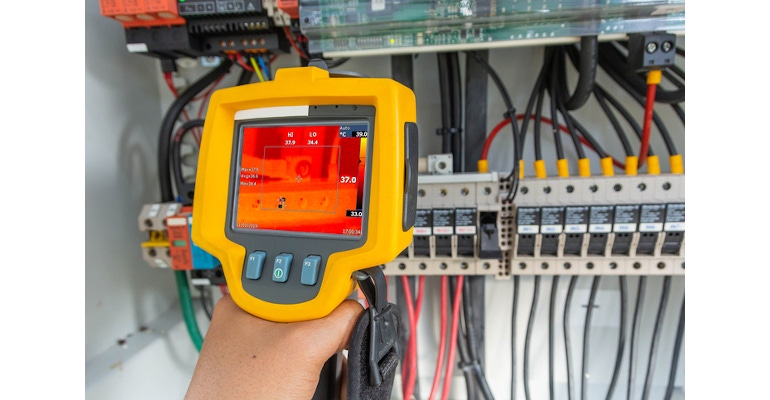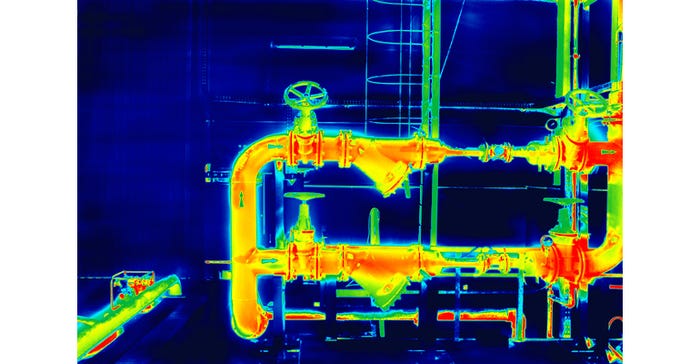Thermography can help identify changes in operating temperatures, which could help prevent downtime and even disaster.

Thermography is an imaging technique increasingly used in manufacturing and processing. How does it work, and why are more companies launching thermography-based predictive maintenance programs for machinery? Get those details and more here.
What Is Thermography?
Thermography—also called thermal imaging—uses specialized cameras to detect radiation in the long-infrared part of the spectrum. That radiation causes heat, and the cameras display a temperature-distribution image that humans can see and study.
The most common reason to use thermography in predictive maintenance is to determine whether a machine is running normally or producing excessive heat.
Thermography’s uses span beyond manufacturing and processing. For example, medical professionals use thermography to detect excessive warmth associated with a patient’s body, and some security professionals use the technique to detect unauthorized persons in restricted areas. Thermal imaging cameras can alert users to heat-radiating objects or bodies, even in total darkness or other challenging conditions, such as fog and smoke.
Using Thermography in Predictive Maintenance
Predictive maintenance centers on making people aware of problems before machine failure occurs. Thus, many consider it an improvement on preventive maintenance, which involves changing parts or performing other upkeep at specified intervals.
The main downside of preventive maintenance is that the suggested schedules do not always reflect real-world conditions. That means someone may change a part far too early or late, even if carefully following the manufacturer’s recommendations.
Predictive maintenance uses sensors and other high-tech tools to detect problems before humans can. For instance, thermal imaging can show someone that a machine’s running too hot before they notice any telltale signs.
Researchers have also investigated applying machine learning to thermography for predictive maintenance. One study resulted in a team building a handheld thermal imaging sensor powered by machine learning. That setup was 94% accurate in finding issues, representing a significant maintenance improvement.
Many thermographic systems for predictive maintenance also allow remote monitoring. Besides making people more aware of operations, they accelerate disaster responses by providing better visibility. Using thermal imaging for predictive maintenance is a viable option even when people are not physically at a chemical plant to provide constant supervision.

Receiving Warnings of Fire Risks
Chemical plants create and prepare substances that can significantly enhance the possibilities for marketable products. Consider how adding 0.003 to 0.005 inches of urethane on one side of a fabric makes it weldable. The processing industry frequently handles flammable materials, and explosions can occur with very little notice. However, thermography equipment can warn people of the associated threats, facilitating a response before fires occur.
Thermal imaging for predictive maintenance is important in helping companies maintain safe environments. Consider one example of a thermographic scan of a switchgear in a chemical plant. It indicated the surface of an A-phase lead’s connection to an air compressor circuit was more than 420 degrees Fahrenheit warmer than the hottest part of the surrounding environment.
The thermography setup flagged the conditions as consistent with a critical fault. Estimates suggested the plant would have been nonoperational for a week and dealt with costs of $1 million if the issue had caused an arc-flash event or fire. Beyond that, the poor connection cost the company excessive energy expenses, making it necessary to fix the problem.
Relatedly, some products made in the manufacturing and processing industries present spontaneous combustion risks, making it essential to have an effective temperature-monitoring system. Just as thermography for predictive maintenance can detect things humans miss, thermal cameras used to find fire risks can measure the heat within product piles or items moved around, such as on conveyor belts.
Deploying Robots to Perform Closer Inspections
People in manufacturing and processing plants and elsewhere have been deploying robots more often, realizing they can get to places some humans can’t. They can also sometimes carry out roles that are extremely dangerous for people to do.
Robots with thermal imaging cameras can inspect pipes and tanks, detecting the excessive heat that could cause a catastrophe if left unaddressed. Using those machines does not eliminate the need for human oversight. However, in the same way using thermography with predictive maintenance could help people spot problems sooner than they otherwise would, robots promote faster awareness of issues. The machines can regularly patrol a plant, checking equipment more often than humans.
Robots with built-in thermography technology can also complement other machines. At one acetylene plant operated by BASF, robots prevent a byproduct called acetylene coke from clogging the combustion chambers. Since the plant has a 90,000-ton annual capacity, it’s a substantial facility. Even the most conscientious humans could overlook something amiss at a plant that size, so machines help fill the visibility gaps.
What Is Thermography’s Future?
These uses of thermography in manufacturing and processing plants show the technique has a bright future. Even though using thermography for predictive maintenance is one of the most common options now, that could gradually change as people explore more possible use cases and see their feasibility.
About the Author(s)
You May Also Like




